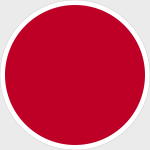DeAgostini DAWF04 Imperial Japanese Army Nakajima Ki-43-II Hayabusa "Oscar" Fighter - MSgt. Akira Sugimoto, 3rd Chutai, 54th Sentai, 1943 [With Collector Magazine] (1:72 Scale)
"We have resolved to endure the unendurable and suffer what is insufferable."
- Japanese Emperor Hirohito speaking to the Japanese people after the atomic bombings, August 1945
 The Nakajima Ki-43 Hayabusa (Peregrine Falcon) was numerically the most important fighter used by the Japanese Army Air Force during the Pacific War. It remained in production from the beginning of the Pacific War until its end in August 1945. In many ways, it was a transitional type, bridging the gap between the lightly-loaded monoplane fighters of the late 1930s with their fixed undercarriages and open cockpits, and the more highly-powered heavy fighters of the early 1940s with their retractable undercarriages and enclosed cockpits.
The Nakajima Ki-43 Hayabusa (Peregrine Falcon) was numerically the most important fighter used by the Japanese Army Air Force during the Pacific War. It remained in production from the beginning of the Pacific War until its end in August 1945. In many ways, it was a transitional type, bridging the gap between the lightly-loaded monoplane fighters of the late 1930s with their fixed undercarriages and open cockpits, and the more highly-powered heavy fighters of the early 1940s with their retractable undercarriages and enclosed cockpits.
Its appearance was a complete surprise to the Allies, and the fighter proved to be superior in performance to most of its opponents during the first year of the Pacific War. Most of the Japanese Army's aces established the larger part of their scores while flying this airplane. The Ki-43 is often confused with its contemporary, the famed Mitsubishi A6M Reisen (Zero Fighter) of the Japanese Navy, and was often misidentified as a "Zero" early in the war.
Pictured here is a 1:72 scale replica of a Japanese Nakajima Ki-43-II Hayabusa "Oscar" fighter that was piloted by Sgt. Kushiro Otake, who was attached to the 25th Sentai, then deployed to Nanking, China, during 1943.
Sold Out!
Dimensions:
Wingspan: 5-1/4-inches
Length: 5-inches
Release Date: October 2019
Historical Account: "Defending the Home Land" - Like the Zero, the Ki-43 initially enjoyed air superiority in the skies of Malaya, Netherlands East Indies, Burma and New Guinea. This was partly due to the better performance of the Oscar and partly due to the relatively small numbers of combat-ready Allied fighters, mostly the Curtiss P-36 Hawk, Curtiss P-40, Brewster Buffalo, Hawker Hurricane and Curtiss-Wright CW-21 in Asia and the Pacific during the first months of the war. As the war progressed, however, the fighter suffered from the same weaknesses as the Ki-27 "Nate" and the A6M Zero; light armor and less-than-effective self-sealing fuel tanks, which caused high casualties in combat. Its armament of two machine guns also proved inadequate against the more heavily armored Allied aircraft. As newer Allied aircraft were introduced, such as the Republic P-47 Thunderbolt, Lockheed P-38 Lightning, North American P-51 Mustang, Vought F4U Corsair, Grumman F6F Hellcat and late-model Supermarine Spitfire/Seafire, the Japanese were forced into a defensive war and most aircraft were flown by inexperienced pilots. However, even near the end, the Oscar's excellent maneuverability could still gain advantage over rash Allied pilots. From October to December 1944, 17 Ki-43s were shot down in air combat; their pilots claimed seven C-47s, five B-24 Liberators, two Spitfires, two Beaufighters, two Mosquitoes, two F4U Corsairs, two B-29 Superfortresses, one F6F Hellcat, one P-38, and one B-25. Like most Japanese combat types, many Hayabusas were at the end expended in kamikaze raids.
The Ki-43 also served in an air defense role over Formosa, Okinawa and the Japanese home islands. Some examples were supplied to the pro-Japanese regimes of Thailand, Manchukuo and Wang Jingwei Government as well. The Thai units sometimes fought against the USAAF in southern China.
Hayabusas were well liked in the JAAF because of the pleasant flight characteristics and excellent maneuverability, and almost all JAAF fighter aces claimed victories with Hayabusa in some part of their career. At the end of the war, most Hayabusa units received Ki-84 Hayate "Frank" fighters, but some units flew the Hayabusa to the end of the war. The top-scoring Hayabusa pilot was Sergeant Satoshi Anabuki with 39 confirmed victories, almost all scored with the Ki-43.
After the war, some captured examples served in limited numbers in the French Air Force in Indochina against Viet Minh rebels.





![US 1/4-Ton Willys Jeep with Bantam T3 Trailer - Unidentified Unit, Normandy, 1944 [D-Day Commemorative Packaging] (1:32 Scale)](http://cdn4.volusion.store/qh9e9-jdqv9/v/vspfiles/photos/UNI81008-1.jpg?v-cache=1740197136)

![Iraqi Air Force General Dynamics F-16D Viper Fighter - 2014 [Low-Vis Scheme] (1:72 Scale)](http://cdn4.volusion.store/qh9e9-jdqv9/v/vspfiles/photos/HA3864-1.jpg?v-cache=1740197136)
